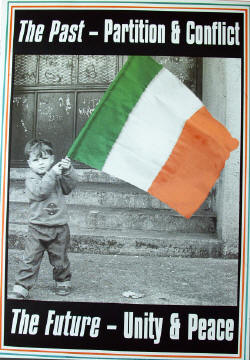 |
Irisch
Republikanische Solidarität
|
 |
'DON'T MENTION THE BORDER'
The Dublin government has rejected calls for a discussion
document on its policy for Irish unity.
Minister for Foreign Affairs Dermot Ahern, who was speaking in
support of Sinn Fein's nationalist rivals, the SDLP, said the
proposed Green Paper was "a red herring" and that nationalists
should be content with an "aspiration for a united Ireland".
"I don't believe a Green Paper would be a relevant document. It's
a red herring," he said of the Sinn Fein proposal.
"Those who are calling for a green paper are doing it to distract
from getting the institutions of the Good Friday Agreement up and
running again.
"People seem to think that a paper would be a panacea for all our
ills. We already have a template for Irish unity in the form of
the Good Friday Agreement which gives nationalists an aspiration
for a united Ireland."
Sinn Fein General Secretary Mitchel McLaughlin described Ahern's
remarks as "a bizarre comment from a senior representative of the
largest republican party on the island".
Mr McLaughlin said "a Green Paper on Irish unity is relevant,
essential and long overdue."
"Instead of running away from this issue there is a
responsibility on the Irish government to take the lead and bring
forward a strategy to achieve national self-determination, Irish
re-unification and national reconciliation.
"However, Minister Ahern comments suggest that Irish unity is no
longer even on the agenda of his party. If that is the case he
should be honest enough to say so and not hide behind the crisis
in the process."
Mr Ahern had claimed the IRA was the main impasse to a united
Ireland. "The IRA is the single biggest barrier to Irish unity,"
he said.
SDLP WANTS UNITY REFERENDUM
Mr Ahern was speaking in Newry as the SDLP yesterday launched its
proposals for achieving a united Ireland within the terms of the
Good Friday Agreement.
In the document, the SDLP has argued that a referendum on Irish
unity in the Six Counties must be the first step towards a united
Ireland.
Those favouring the union with Britain currently retain their
built-in majority in the Six County area created by the 1922
partition of Ireland. The 1998 Good Friday Agreement allows for
border polls (Six-County referenda) every seven years, and many
believe this unionist majority is slowly disappearing under
demographic, political and cultural change.
An overwhelming majority on the island of Ireland favours
reunification.
The SDLP argues that unionists would begin negotiations on a
united Ireland following a border poll.
The party also wants to retain the Belfast Assembly within a
united Ireland, an idea similar in many respects to the federal
model proposed by Republican Sinn Fein.
In the paper 'A United Ireland and the Agreement', the SDLP
argues that nationalism must embrace unionism more "not because
the numbers tell us we must, but because our desire for a
peaceful future on this island as equals and as partners tells us
we should."
Leader Mark Durkan said the party was now seeing agreement on the
date for a referendum on a United Ireland - and that Sinn Fein,
the DUP and UUP already supported holding a referendum.
But the paper also admitted winning a referendum would be much
more difficult "if voters know nothing of how they will be
governed afterwards".
The proposals mark the opening of the SDLP's formal campaign for
the Westminster General Election, expected to be announced in the
next few weeks.
Commenting on the proposals, Sinn Fein's Mitchel McLaughlin said
that the apparent shift by the SDLP from the politics of "post
nationalism" to the politics of Irish Unity was welcome. But he
added: "The Sinn Fein demand for Irish Independence and Unity has
always been up front and clear. The same cannot be said of the
SDLP."
Letzte Änderung:
27-März-05